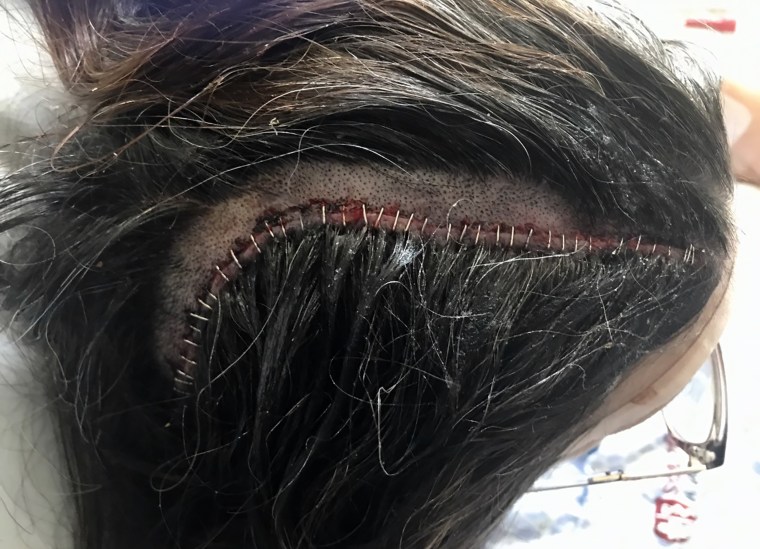By the time Robyn Baldwin signed up for a brain implant to control her intense urge to overeat, she had been struggling with her weight for decades.
“I have always been big my whole life,” Baldwin, 58, who lives in Citrus Heights, California, tells TODAY.com.
“I always categorized myself as a grazer. I would just eat all day long. I never realized how bad of a binge eater I was.”
 Weight-loss surgery failed for Robyn Baldwin so she tried deep brain stimulation to get her food cravings under control. Courtesy Robyn Baldwin
Weight-loss surgery failed for Robyn Baldwin so she tried deep brain stimulation to get her food cravings under control. Courtesy Robyn Baldwin
In 2003, she reached 332 pounds, her highest weight ever, and underwent gastric bypass surgery to treat her severe obesity. It worked for a while: Baldwin lost about 130 pounds and kept it off for seven years.
But when her husband developed a brain tumor and she became his sole caregiver while also working full time as a government analyst, the stress became too much. She began overeating again and gained all the weight back.
“I love ice cream to the point where I would eat it until I got sick,” Baldwin says. “I’m a big binge eater of pasta. If we make a big bowl of spaghetti, I can just sit there and binge on it in the pot right there.”
Even weight-loss surgery sometimes can’t stop such intense cravings and the uncontrollable desire to keep eating, the authors of a new study say. When the binges happen over and over again, such episodes indicate binge-eating disorder, which affects up to 3% of adults in the U.S., they note.
Baldwin recalls binging several times a week “easy.”
“A lot of (weight-loss surgery) patients still suffer from these undying urges to overeat,” Dr. Casey Halpern, study co-author and chief of stereotactic and functional neurosurgery at Penn Medicine in Philadelphia, tells TODAY.com.
“We believe these patients are not able to control themselves, and that’s not because they’re weak. It’s because they have dysfunction of the circuits in the brain involved in self-control.”
Photos of dessert during surgery
To target those circuits, Halpern and his colleagues believe a deep brain stimulation device — which is already used to control the tremors of Parkinson’s disease and the seizures of epilepsy — could help people who lose control around food.
The researchers recruited Baldwin and another woman with binge eating disorder for a pilot study to test if that was the case.
To implant the device, doctors make a small opening in the patient’s skull and insert tiny wires into the nucleus accumbens, a region deep in the brain that’s a key hub of rewards circuits, Halpern said.
The wires are connected to a stimulator, which is like a computer chip that sits under the scalp within the skull bone. When it detects craving signals in the brain, it sends a bit of electricity to disrupt them, potentially helping a patient regain control around food.
Baldwin says she wasn’t nervous about the surgery, which took place July of 2020. She was awake during the procedure and was asked to look at photos she submitted of her favorite binge foods — including crème brulee, meals from Taco Bell and peanut butter M&Ms — so that doctors could detect how her brain responded.
“We were able to actually activate craving cells in the nucleus accumbens and hear their signal in the context of seeing pictures of food,” Halpern says. The nucleus accumbens is “typically … very quiet. But if you provoke it, all of a sudden you hear activated cells” as their electric charge changes.
These cells didn’t activate when Baldwin looked at photos of food she didn’t find appetizing. It confirmed that doctors found “the sweet spot” in her brain for curbing cravings, Halpern explains. The stimulator was then ready to intercept them.
 The scar after surgery to implant the stimulation device.Courtesy Robyn Baldwin
The scar after surgery to implant the stimulation device.Courtesy Robyn Baldwin
No more cravings for ice cream
Once implanted, doctors didn’t activate the device right away and didn’t tell the women when it would be turned on to rule out any placebo effect. But when it was finally turned on permanently, Baldwin says she felt a difference right away.
“I wasn’t having any cravings for anything. I wasn’t overeating anything,” she says. “I’m not thinking about food all the time like I was before. It’s not total consuming thought. I can actually say, ‘Hey, I forgot to eat lunch today,’ which was never in my vocabulary before.”
Baldwin says she now eats a regular breakfast instead of “being a hobbit and having a first breakfast, second breakfast, elevenses and lunch.” She can also have a spoonful of ice cream and stop, instead of eating it until she was sick.
 The main goal of the pilot study was self-control around food, researchers say, which can lead to weight loss. Baldwin has lost 35 pounds so far.Courtesy Robyn Baldwin
The main goal of the pilot study was self-control around food, researchers say, which can lead to weight loss. Baldwin has lost 35 pounds so far.Courtesy Robyn Baldwin
She says she can feel the device implanted in her skull as a raised bump on her head, but can’t feel the zap of electricity it sends to disrupt the craving signals deep her brain.
“We’re providing a level of stimulation that’s so small they can’t perceive it, but their brain circuits perceive it and change in response to that,” Halpern says.
Baldwin has lost 35 pounds since the study started, continues to lose weight and wants to keep the implant permanently, she says. The other woman in the study has also lost weight and also wants to keep the device, Halpern adds.
“I’m never going to be one of those people who say ‘I love kale’ because that’s not going to happen, but it definitely changed the way I deal with food now,” Baldwin notes.
“I’ll always have a battle with weight. … I know this is not the end-all cure. This is just an added tool for me, and it’s helping.”
This was a pilot study with only two people, so much more research about this approach is required. Halpern and his colleagues are now looking for four people to take part in a clinical trial. They’d like to recruit people who are obese, underwent weight-loss surgery at least two years prior, and feel they can’t control themselves around food.
A multicenter study with 40 to 100 patients could follow, with the goal of getting approval from the U.S. Food and Drug Administration. That’s years away at this point, but Halpern is excited about the potential.
“If this were effective for patients with obesity who suffered from these types of food cravings, presumably we could extend that to other psychiatric problems, like addiction and alcoholism,” he says.

